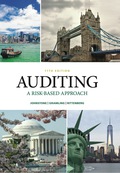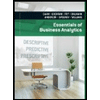
EBK AUDITING: A RISK BASED-APPROACH
11th Edition
ISBN: 9781337670203
Author: RITTENBERG
Publisher: YUZU
expand_more
expand_more
format_list_bulleted
Concept explainers
Question
Chapter 7, Problem 19RQSC
a)
To determine
Introduction: Potential risk is the risk which is an expected in an action by the Auditor. This risk is the damage factor to the genuineness of the operations of a client.
To Explain:The potential risk areas and explanation for these risk areas and the description of potential risk areas affecting the audit engagement.
b)
To determine
Introduction: Potential Skepticism is the alertness factor of the working style of an Auditor who is prepared to handle any probable misstatement during the course of audit.
To Explain:The data which compels the auditor to use professionalism level while exercising in audit.
Expert Solution & Answer
Trending nowThis is a popular solution!

Students have asked these similar questions
Calculate the division return on assets
Please give me true answer this financial accounting question
Raptors Inc. creates aluminum alloy parts for commercial aircraft. In a recent transaction Raptors leased a high precision lathe machine from Grizzlies Corp. on January 1, 2024. The following information pertains to the leased asset and the lease agreement:
Cost of lathe to lessor
$140,000
Grizzlies normal selling price for lathe
178,268
Useful life
7 years
Estimated value at end of useful life
8,000
Lease provisions
Lease term
5 years
Payment frequency
Annual
Start date of lease
January 1
Payment timing
December 31
Estimated residual value at end of lease (unguaranteed)
20,000
Interest rate implicit in the lease (readily determinable by lessee)
7%
Lessee's incremental borrowing rate
8%
The lathe machine will revert back to the lessor at end of lease term, title does not transfer to lessee at any time, and there is not a bargain purchase option.
Required…
Chapter 7 Solutions
EBK AUDITING: A RISK BASED-APPROACH
Ch. 7 - Prob. 1CYBKCh. 7 - Prob. 2CYBKCh. 7 - Prob. 3CYBKCh. 7 - Prob. 4CYBKCh. 7 - Prob. 5CYBKCh. 7 - Prob. 6CYBKCh. 7 - Prob. 7CYBKCh. 7 - Prob. 8CYBKCh. 7 - Prob. 9CYBKCh. 7 - Prob. 10CYBK
Ch. 7 - Prob. 11CYBKCh. 7 - Prob. 12CYBKCh. 7 - Prob. 1RQSCCh. 7 - Prob. 2RQSCCh. 7 - Prob. 3RQSCCh. 7 - Prob. 4RQSCCh. 7 - Prob. 7RQSCCh. 7 - Prob. 8RQSCCh. 7 - How does inherent risk relate to internal...Ch. 7 - Prob. 10RQSCCh. 7 - Prob. 11RQSCCh. 7 - Prob. 12RQSCCh. 7 - Prob. 13RQSCCh. 7 - Prob. 14RQSCCh. 7 - Prob. 15RQSCCh. 7 - Prob. 17RQSCCh. 7 - Prob. 18RQSCCh. 7 - Prob. 19RQSCCh. 7 - Prob. 22RQSCCh. 7 - Prob. 23RQSCCh. 7 - Prob. 24RQSCCh. 7 - Prob. 25RQSCCh. 7 - Prob. 26RQSCCh. 7 - Prob. 27RQSCCh. 7 - Prob. 29FF
Knowledge Booster
Learn more about
Need a deep-dive on the concept behind this application? Look no further. Learn more about this topic, accounting and related others by exploring similar questions and additional content below.Similar questions
- Financial Accountingarrow_forwardCan you please solve this financial accounting problem without use Ai?arrow_forwardHobbiton Tours Ltd. has the following details related to its defined benefit pension plan as at December 31, 2024: Pension fund assets of $1,900,000 and actuarial obligation of $1,806,317. The actuarial obligation represents the present value of a single benefit payment of $3,200,000 that is due on December 31, 2030, discounted at an interest rate of 10%; i.e. $3,200,000 / 1.106 = $1,806,317. Funding during 2025 was $55,000. The actual value of pension fund assets at the end of 2025 was $2,171,000. As a result of the current services received from employees, the single payment due on December 31, 2030, had increased from $3,200,000 to $3,380,000. Required Compute the current service cost for 2025 and the amount of the accrued benefit obligation at December 31, 2025. Perform this computation for an interest rate of 8%. Derive the pension expense for 2025 under various assumptions about the expected return and discount rate. Complete the following table: Case…arrow_forward
- Calculate Debt Ratios and Debt to Equity Ratio for 2016arrow_forwardPlease explain the correct approach for solving this financial accounting question.arrow_forwardIn 2026, Maple Leafs Co. sells its single machine, which cost $100,000 and has an undepreciated capital cost (UCC) of $25,000 for tax purposes. For financial reporting, the machine has carrying amount of $40,000. The sale price of the machine is $30,000. Aside from the sale of the machine, the company has other income (before taxes) of $600,000, which includes non-taxable dividends of $120,000 dollars received during the year. There are no other permanent or temporary differences. The company faces an income tax rate of 35%. Required Provide the journal entries for the company for 2026.arrow_forward
- Blue Jays Corporation started operations on March 1, 2025. It needs to acquire a special piece of equipment for its manufacturing operations. It is evaluating two options as follows. Option 1: Lease the equipment for 5 years. Lease payments would be $11,000 per year, due at the beginning of each fiscal year (March 1). Blue Jays incremental borrowing rate is 5%. There is not a bargain purchase or renewal option. Blue Jays is responsible for all non-lease costs of operating the equipment. Option 2: Purchase the equipment for $50,000 by borrowing the full purchase amount at 5% over 5 years. This price is considered the fair value of the equipment. Payments are due at the end of each fiscal year (February 28). The equipment has a useful life of 5 years and would be depreciated on a straight-line basis. No residual value is expected to exist at the end of 5 years. Required Calculate the present value of the lease payments (Option 1). Calculate the payment that would be…arrow_forwardI need help finding the accurate solution to this financial accounting problem with valid methods.arrow_forwardFinancial Accountingarrow_forward
arrow_back_ios
SEE MORE QUESTIONS
arrow_forward_ios
Recommended textbooks for you
 Auditing: A Risk Based-Approach (MindTap Course L...AccountingISBN:9781337619455Author:Karla M Johnstone, Audrey A. Gramling, Larry E. RittenbergPublisher:Cengage Learning
Auditing: A Risk Based-Approach (MindTap Course L...AccountingISBN:9781337619455Author:Karla M Johnstone, Audrey A. Gramling, Larry E. RittenbergPublisher:Cengage Learning Auditing: A Risk Based-Approach to Conducting a Q...AccountingISBN:9781305080577Author:Karla M Johnstone, Audrey A. Gramling, Larry E. RittenbergPublisher:South-Western College Pub
Auditing: A Risk Based-Approach to Conducting a Q...AccountingISBN:9781305080577Author:Karla M Johnstone, Audrey A. Gramling, Larry E. RittenbergPublisher:South-Western College Pub- Principles of Accounting Volume 1AccountingISBN:9781947172685Author:OpenStaxPublisher:OpenStax College
 Essentials Of Business AnalyticsStatisticsISBN:9781285187273Author:Camm, Jeff.Publisher:Cengage Learning,
Essentials Of Business AnalyticsStatisticsISBN:9781285187273Author:Camm, Jeff.Publisher:Cengage Learning,

Auditing: A Risk Based-Approach (MindTap Course L...
Accounting
ISBN:9781337619455
Author:Karla M Johnstone, Audrey A. Gramling, Larry E. Rittenberg
Publisher:Cengage Learning


Auditing: A Risk Based-Approach to Conducting a Q...
Accounting
ISBN:9781305080577
Author:Karla M Johnstone, Audrey A. Gramling, Larry E. Rittenberg
Publisher:South-Western College Pub

Principles of Accounting Volume 1
Accounting
ISBN:9781947172685
Author:OpenStax
Publisher:OpenStax College

Essentials Of Business Analytics
Statistics
ISBN:9781285187273
Author:Camm, Jeff.
Publisher:Cengage Learning,